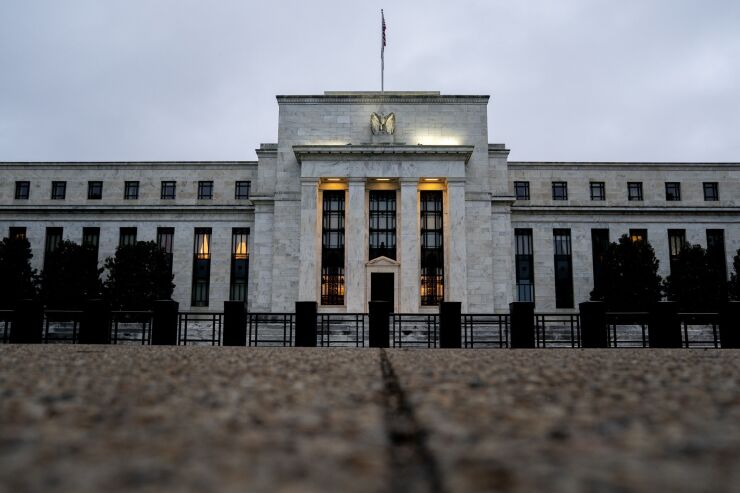
As freshly appointed agency heads aim to refocus their approaches to supervision, an emerging question is how much discretion will be left for bank examiners — if any at all.
Regulators and lawmakers have already sought to remove one key discretionary tool by barring the consideration of reputational risks. But some policy specialists want them to go further.
During a
"While this framework in theory evaluates six factors, it is the management rating — or the 'M' — that dominates as a factor in the composite rating," said Sarah Flowers, a top regulatory affairs official with the Bank Policy Institute, during that hearing.
Like others in and around the banking space, Flowers said she is frustrated by the management component's lack of objectivity because it focuses primarily on examiner interpretations of bank practices rather than hard financial data.
"The management rating is uniquely subjective," she said. "It is not based on any empirical or financial standard, but rather serves as a vehicle by which examiners can find fault with any aspect of a bank's compliance program or the bank's willingness to accede to examiner mandates."
Flowers added that management decisions reflect in everything a bank does, arguing that if deficiencies exist, they will manifest in measurable ways in other parts of the examination process.
But other policy experts say that by the time management issues are showing up on a bank's balance sheet, it can be too late. Sarah Bloom Raskin, a former Federal Reserve Board governor and deputy Treasury secretary during the Obama administration, said the current examination approach appropriately reflects the importance of good management.
"How the bank is managed is key to the overall safety and soundness of a bank," Bloom Raskin said. "Yes, it can involve some judgment calls and some prudent discretion, but trained examiners understand how to exercise judgment and discretion in a way that provides good guidance for bank leaders."
Others, particularly those with regulatory experience, say the amount of discretion provided to examiners under the current framework is often overstated.
Shayna Olesiuk, director of banking policy at the consumer advocacy group Better Markets and a former Federal Deposit Insurance Corp. official, said examiners are tasked with making "supervisory judgments" when downgrading a bank for management concerns. These decisions, she said, are based on protocol and years of training and experience, adding that examiners must also explain their findings.
"If there's a way to make the proof and evidence that's required before determining the M rating more specific or more detailed, I would certainly be in favor of that," Olesiuk said. "But getting rid of it altogether, to me, is a huge mistake."
What is the CAMELS rating of banks?
CAMELS is a decades-old rating system used by the Federal Reserve, Federal Deposit Insurance Corp. and the Office of the Comptroller of the Currency. Banks are scored in each category on a one through five basis, with one being the strongest score and five being the most deficient. Based on those scores, banks are given a composite rating. Those with an overall score of four or five are deemed troubled, receive enhanced oversight and are generally prohibited from merging with other banks or opening new branches.
But the composite score is not calculated by a simple averaging of the five categories. Significant issues in any one component of the examination could render the bank non-satisfactory. This is another point of contention among those who feel the CAMELS system is in need of an overhaul.
During a speech in February, Fed Gov. Michelle Bowman — the Trump administration's pick to be the central bank's next top regulator — suggested that banks were being deemed unsound despite meeting all their regulatory expectations. She pointed to the Fed's latest supervision and regulation report, which notes that two-thirds of large banks have less-than-satisfactory ratings in at least one exam component, while at the same time asserting that most banks had sufficient capital and liquidity.
"The odd mismatch between financial condition and overall supervisory condition as assessed by the prudential regulators raises a more significant issue: whether subjective examiner judgment — those evaluations based on subjective, examiner-driven, non-financial concerns — is driving the firm's overall rating," Bowman said. "Are ratings trends based on the materiality of the identified issues, or do they imply that the regulators see widespread fragility in the banking system?"
During her
Governance is among the most important parts of management examination, for parties on both sides of the reform debate. It is also one of the more difficult areas to parse for quality.
Meg Tahyar, head of the financial institutions group and a partner at the law firm Davis Polk & Wardwell, said often the evaluation focuses more on processes than outcomes.
"It's about checks and balances, making sure the appropriate people make the appropriate decisions in the appropriate way, not about making dozens of committees," she said. "It shouldn't be about making a big internal bureaucracy."
Getting over the hump
Tahyar said a fresh look at the CAMELS system is overdue, and while any revisions to the framework should preserve examiner judgment, it should also place stricter guardrails around them.
"Supervisors have to be able to exercise judgment — but the question is, when they are exercising qualitative judgment, are they doing it around a quantitative standard or is it totally unmoored?" Tahyar said. "The discretion needs to be anchored to something empirical."
Karen Petrou, managing partner of Federal Financial Analytics, said there are ways to put quantitative measures around seemingly qualitative factors. She noted that governance could be examined by establishing benchmarks for things such as executive compensation and board composition against which individual banks can be measured.
Petrou said management examination is critical, noting that it is often an early indicator of future issues — but only when done correctly.
"I would like it refined, and if the agencies think they cannot refine it, then I want it out," she said. "It needs to be a largely quantitative, transparent and accountable measure of managerial controls."
There are differing views about when the level of discretion used by examiners under the management component of CAMELS became an issue. Some say it was after the financial crisis in 2008, when a string of bank failures caused agency priorities to shift. Others believe it to be a
Notably, both proponents for removing management oversight and emboldening it see the
Bloom Raskin said the debate about the merits underlying the CAMELS approach predates the ratings system itself. Despite that acrimony, she said overhauling the framework does not amount to an urgent call to action for regulators.
"Both the virtues and drawbacks of CAMELS have been with us for as long as there has been bank examination," she said. "I'm sure there could be ways to think about bank examination differently. But in the meantime, there is no credible evidence that this part of the bank examination system is broken, so [there is] no need to be in search of a problem when there are others to focus on."






